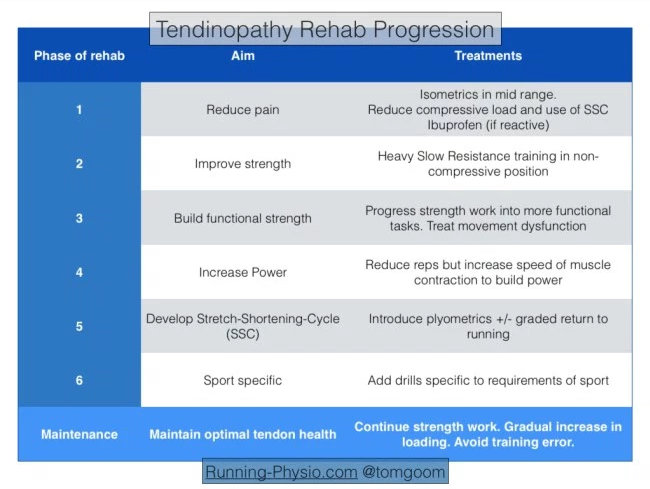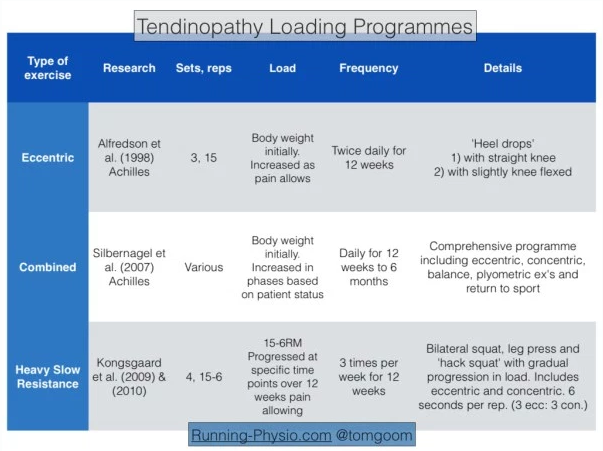Tendinopathy Rehabilitation: Difference between revisions
No edit summary |
No edit summary |
||
| Line 16: | Line 16: | ||
[[Image:Tendinopathy rehab progression.png|center]] | [[Image:Tendinopathy rehab progression.png|center]] | ||
=== Phase 1 - reduce pain<br> === | === Phase 1 - reduce pain<br> === | ||
Key to reducing pain is managing the load on the tendon: | Pain is a key presentation in the reactive phase. Key to reducing pain is managing the load on the tendon: | ||
#Avoid activities that place a compressive load on the tendon, usually this is any activity that would involve stretching the effected muscle or direct tendon compression. | #Avoid activities that place a compressive load on the tendon, usually this is any activity that would involve stretching the effected muscle or direct tendon compression. | ||
#Cut out activities that involve the Stretch-Shortening-Cycle (SSC) | #Cut out activities that involve the Stretch-Shortening-Cycle (SSC) which occurs when the tendon has to behave a like a spring, stretching then shortening to store and then release energy. | ||
#Isometric exercises can help to reduce pain<ref name="Rio1">Ebonie Rio, Dawson Kidgell, Craig Purdam, Jamie Gaida, G Lorimer Moseley, Alan J Pearce, Jill Cook. [http://bjsm.bmj.com/content/49/19/1277.abstract?cited-by=yes&amp;legid=bjsports;49/19/1277 Isometric exercise induces analgesia and reduces inhibition in patellar tendinopathy]. Br J Sports Med 2015;49:1277–1283.</ref><ref name="Rio2">Mathijs van Arka, Jill L. Cookb, Sean I. Dockingb, Johannes Zwervera, James E. Gaidab, Inge van den Akker-Scheeka, Ebonie Riob. [http://www.sciencedirect.com/science/article/pii/S1440244015002315 Do isometric and isotonic exercise programs reduce pain in athletes with patellar tendinopathy in-season? A randomised clinical trial]. Journal of Science and Medicine in Sport, available online 7 December 2015</ref>. These exercises should be done in a position where there is no tendon compression, usually in the mid-range of the muscle. | |||
#Anti-inflammatory medications, such as ibuprofen can be used to help to reduce the reactive response. | #Anti-inflammatory medications, such as ibuprofen can be used to help to reduce the reactive response. | ||
=== Phase 2 - improve stength === | === Phase 2 - improve stength === | ||
Once pain has settled you can progress to phase 2 and work on strength. Research has focused on tendinopathy loading programmes that generally fit within 3 categories eccentric, combined or heavy slow resistance training. Goon<ref name="Goon1" /> summarises the evidence for lower limb strength programmes: | |||
[[Image:Tendinopathy Loading programmes.png|center]]<span style="font-size: 13.28px; line-height: 19.92px;">For this phase of rehab you are aiming to achieve strength changes by exercising with sufficient load in a a muscle’s mid-range position. Avoid exercising with heavy loads in positions where there is likely to be tendon compression</span><ref name="Goon1" /><span style="font-size: 13.28px; line-height: 19.92px;">. Following research by Alfredson et al<ref>Håkan Alfredson, Tom Pietilä, Per Jonsson and Ronny Lorentzon. [http://yaroslavvb.com/papers/alfredson-heavy.pdf Heavy-Load Eccentric Calf Muscle Training For the Treatment of Chronic Achilles Tendinosis]. Am J Sports Med 1998 26: 360</ref>. eccentric exercises have been considered the gold standard for many years. More recently research has demonstrated the importance of also including the concentric phase of exercises with heavy slow resistance training<ref name="Gaida">Gaida JE1, Cook J. [http://www.ncbi.nlm.nih.gov/pubmed/23531972 Treatment options for patellar tendinopathy: critical review]. Curr Sports Med Rep. 2011 Sep-Oct;10(5):255-70.</ref>.</span> | |||
Revision as of 19:21, 30 January 2016
Original Editor - Your name will be added here if you created the original content for this page.
Top Contributors - Admin, Rachael Lowe, Tarina van der Stockt, Jess Bell, Kim Jackson, Rucha Gadgil, Wanda van Niekerk, Claire Knott, Lucinda hampton, Robin Tacchetti, 127.0.0.1, Naomi O'Reilly, WikiSysop and Fasuba Ayobami
Introduction[edit | edit source]
The development of a rehabilitation plan for an individual presenting with confirmed symptomatic tendinopathy requires complex clinical reasoning, with reference to the pathoanatomical diagnosis. Tendon pathology and subsequent rehabilitation will vary considerably depending on the site of pathology; stage of the tendinopathy; functional assessment; activity status of the person; contributing issues throughout the kinetic chain; comorbidities; and concurrent presentations[1].
Our key goal in tendinopathy rehabilitation is improving the capacity of the tendon and muscle to manage load[2]. Each component of the rehabilitation programme, in particular loading, must be manipulated in relation to the nature, speed and magnitude of the forces applied to the muscle/tendon/bone unit in order to achieve the goals of the particular management phase without causing an exacerbation of the pathological state or pain[1].
Rehabilitation Progression[edit | edit source]
Goon[2][3] suggests considering tendinopathy rehabilitation in phases:
Phase 1 - reduce pain
[edit | edit source]
Pain is a key presentation in the reactive phase. Key to reducing pain is managing the load on the tendon:
- Avoid activities that place a compressive load on the tendon, usually this is any activity that would involve stretching the effected muscle or direct tendon compression.
- Cut out activities that involve the Stretch-Shortening-Cycle (SSC) which occurs when the tendon has to behave a like a spring, stretching then shortening to store and then release energy.
- Isometric exercises can help to reduce pain[4][5]. These exercises should be done in a position where there is no tendon compression, usually in the mid-range of the muscle.
- Anti-inflammatory medications, such as ibuprofen can be used to help to reduce the reactive response.
Phase 2 - improve stength[edit | edit source]
Once pain has settled you can progress to phase 2 and work on strength. Research has focused on tendinopathy loading programmes that generally fit within 3 categories eccentric, combined or heavy slow resistance training. Goon[2] summarises the evidence for lower limb strength programmes:
For this phase of rehab you are aiming to achieve strength changes by exercising with sufficient load in a a muscle’s mid-range position. Avoid exercising with heavy loads in positions where there is likely to be tendon compression[2]. Following research by Alfredson et al[6]. eccentric exercises have been considered the gold standard for many years. More recently research has demonstrated the importance of also including the concentric phase of exercises with heavy slow resistance training[7].
Recent Related Research (from Pubmed)[edit | edit source]
Extension:RSS -- Error: Not a valid URL: Feed goes here!!|charset=UTF-8|short|max=10
References[edit | edit source]
References will automatically be added here, see adding references tutorial.
- ↑ 1.0 1.1 Alex Scott, Sean Docking, Bill Vicenzino, Håkan Alfredson, Johannes Zwerver, Kirsten Lundgreen, Oliver Finlay, Noel Pollock, Jill L Cook, Angela Fearon, Craig R Purdam, Alison Hoens, Jonathan D Rees, Thomas J Goetz, Patrik Danielson. Sports and exercise-related tendinopathies: a review of selected topical issues by participants of the second International Scientific Tendinopathy Symposium (ISTS) Vancouver 2012. Br J Sports Med doi:10.1136/bjsports-2013-092329
- ↑ 2.0 2.1 2.2 2.3 Goon T. Tendinopathy – rehab progression – part 1. Accessed online at Tendinopathy – rehab progression – part 1 30 Jan 2016
- ↑ Goon T. Tendinopathy – functional rehab. Accessed online at Tendinopathy – rehab progression – part 1 30 Jan 2016
- ↑ Ebonie Rio, Dawson Kidgell, Craig Purdam, Jamie Gaida, G Lorimer Moseley, Alan J Pearce, Jill Cook. Isometric exercise induces analgesia and reduces inhibition in patellar tendinopathy. Br J Sports Med 2015;49:1277–1283.
- ↑ Mathijs van Arka, Jill L. Cookb, Sean I. Dockingb, Johannes Zwervera, James E. Gaidab, Inge van den Akker-Scheeka, Ebonie Riob. Do isometric and isotonic exercise programs reduce pain in athletes with patellar tendinopathy in-season? A randomised clinical trial. Journal of Science and Medicine in Sport, available online 7 December 2015
- ↑ Håkan Alfredson, Tom Pietilä, Per Jonsson and Ronny Lorentzon. Heavy-Load Eccentric Calf Muscle Training For the Treatment of Chronic Achilles Tendinosis. Am J Sports Med 1998 26: 360
- ↑ Gaida JE1, Cook J. Treatment options for patellar tendinopathy: critical review. Curr Sports Med Rep. 2011 Sep-Oct;10(5):255-70.








